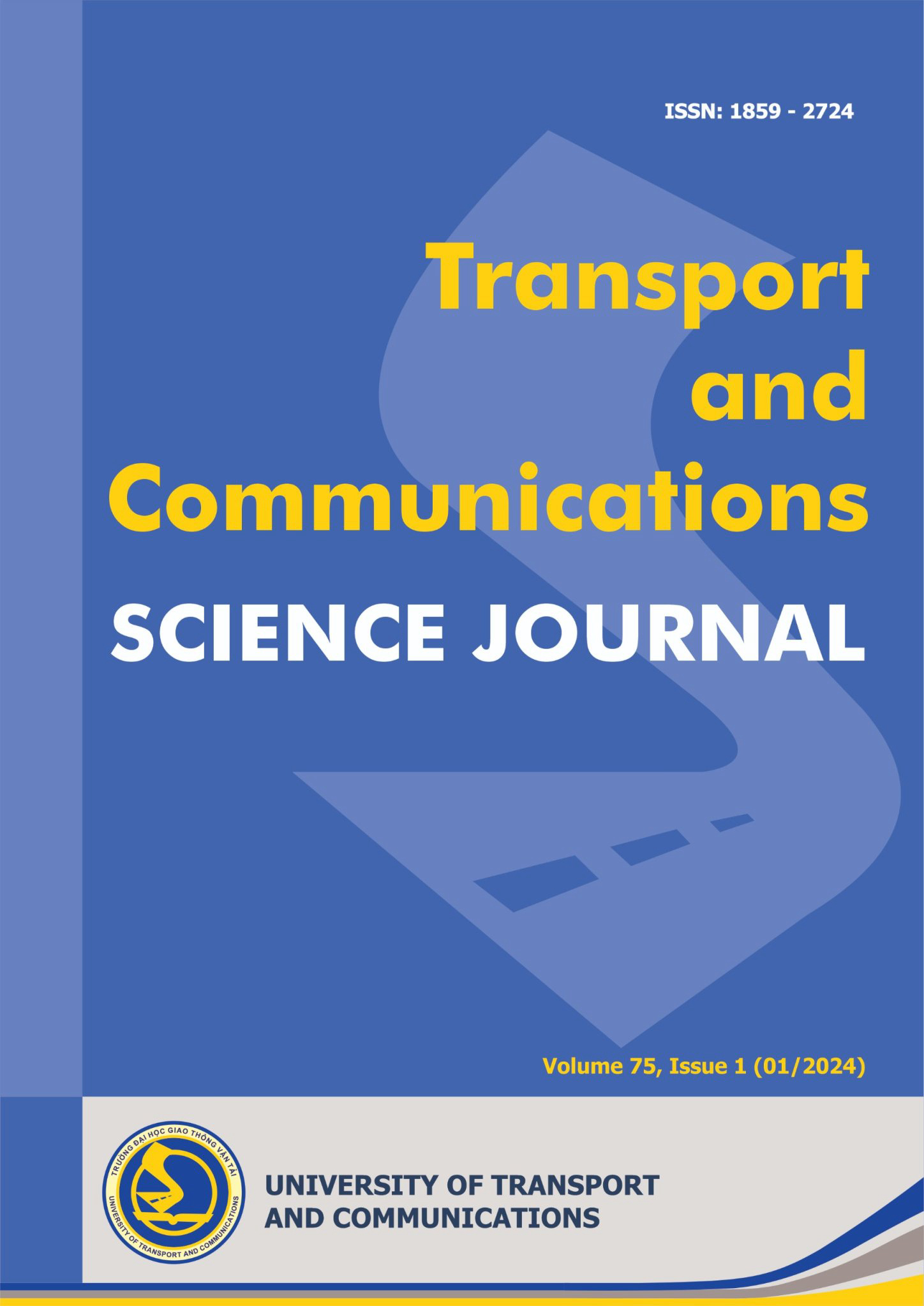Computation of the effective permeability of 2D doubly porous materials with elliptical shaped pores by using boundary element method
Email:
tbthao.tran@utc.edu.vn
Từ khóa:
BEM, effective permeability, double porosity, coupled Stokes-Darcy problem, fluid-filled inclusion.
Tóm tắt
In recent years, the prediction of the effective transport properties have received a great number of investigations. The present work is dedicated to determining the effective permeability of two-dimensional (2D) doubly porous materials made of an isotropic permeable solid matrix in which elliptical shaped pores of any size are embedded. At the interface between the fluid and the solid, the Beaver–Joseph–Saffman conditions are applied. To achieve this objective, the Boundary Element Method (BEM) is first elaborated in the simulation of velocity and pressure solution fields of two coupled Stokes and Darcy problems. Afterwards, with the help of this solution results, the effective permeablity of the doubly porous material under investigation can be determined. For the purpose of assessing the accuracy and convergence of the BEM solution, the results obtained for the velocity and pressure fields are compared with the ones provided by the finite element method (FEM). Finally, several numerical examples are carried out to analyze the fluid/solid interface influence, the effect of area fraction and geometrical properties of pores, such as the size and distribution of the pores within the matrix phase.Tài liệu tham khảo
[1]. G. S. Beavers, D. D. Joseph, Boundary conditions at a naturally permeable wall, J.Fluid. Mech., 30 (1967) 197–207. https://doi.org/10.1017/S0022112067001375
[2]. P. G. Saffman, On the boundary condition at the surface of a porous medium, Stud. Appl. Math., L2, (1971) 93-101. https://doi.org/10.1002/sapm197150293
[3]. J. L. Auriault, E. Sanchez-Palencia, Etude du comportement macroscopique d’un milieu poreux saturé déformable, J. Mecanique, 16 (1977) 575-603.
[4]. E. Sanchez-Palencia, Non-homogeneous media and vibration theory, Lecture Notes in Physics, 127 (1981). https://doi.org/10.1007/3-540-10000-8
[5]. S. Whittaker, Diffusion and dispersion in porous media, AlchE J., 13 (1967) 420-432. https://doi.org/10.1002/aic.690130308
[6]. J. Barrere, J. -P. Caltagirone, O. Gipouloux, Détermination numérique de la perméabilité en mileu poreux périodique tridimensionnel, C. R. Acad. Sci., 310 (1990) 347-352.
[7]. D. Cioranescu, P. Donato, H. I. Ene, Homogenization of the Stokes problem with non-homogeneous slip boundary conditions, Math. Methods Appl. Sci., 19 (1996) 857-881. https://doi.org/10.1002/(SICI)1099-1476(19960725)19:11<857::AID-MMA798>3.0.CO;2-D
[8]. F. Alcocer, P. Singh, Permeability of periodic porous media, Phys. Rev. E, 59 (1999) 771. https://doi.org/10.1103/PhysRevE.59.711
[9]. F. Alcocer, P. Singh, Permeability of periodic arrays of cylinders for viscoelastic flows, Phys. Fluids, 14 (2002) 2578-2581. https://doi.org/10.1063/1.1483301
[10]. H. -B. Ly, B. Le Droumaguet, V. Monchiet, D. Grande, Designing and modeling double porous polymeric materials, Eur. Phys. J. Special Topics, 224 (2015) 1689-1706. https://doi.org/10.1140/epjst/e2015-02491-x
[11]. V. Monchiet, G. Bonnet, G. Lauriat, A fft-based method to compute the permeability induced by a stokes slip flow through a porous medium, C. R. Mécanique, 337 (2009) 192-197. https://doi.org/10.1016/j.crme.2009.04.003
[12]. T. -K. Nguyen, V. Monchiet, G. Bonnet, A Fourier based numerical method for computing the dynamic permeability of periodic porous media, Eur. J. Mech. B-Fluid, 37 (2013) 90-98. https://doi.org/10.1016/j.euromechflu.2012.07.004
[13]. H. -B. Ly, V. Monchiet, D. Grande, Computation of permeability with fast Fourier transform from 3-D digital images of porous microstructures, Int. J. Numer. Methods Heat Fluid Flow, 26 (2016) 1328-1345. https://doi.org/10.1108/HFF-12-2014-0369
[14]. C. Pozrikidis, Boundary integral and singularity methods for linearized viscous flow, Cambridge University Press, Cambridge, 1992.
[15]. J. T. Katsikadelis, Boundary elements: Theory and applications, Elsevier, Amsterdam, 2002.
[2]. P. G. Saffman, On the boundary condition at the surface of a porous medium, Stud. Appl. Math., L2, (1971) 93-101. https://doi.org/10.1002/sapm197150293
[3]. J. L. Auriault, E. Sanchez-Palencia, Etude du comportement macroscopique d’un milieu poreux saturé déformable, J. Mecanique, 16 (1977) 575-603.
[4]. E. Sanchez-Palencia, Non-homogeneous media and vibration theory, Lecture Notes in Physics, 127 (1981). https://doi.org/10.1007/3-540-10000-8
[5]. S. Whittaker, Diffusion and dispersion in porous media, AlchE J., 13 (1967) 420-432. https://doi.org/10.1002/aic.690130308
[6]. J. Barrere, J. -P. Caltagirone, O. Gipouloux, Détermination numérique de la perméabilité en mileu poreux périodique tridimensionnel, C. R. Acad. Sci., 310 (1990) 347-352.
[7]. D. Cioranescu, P. Donato, H. I. Ene, Homogenization of the Stokes problem with non-homogeneous slip boundary conditions, Math. Methods Appl. Sci., 19 (1996) 857-881. https://doi.org/10.1002/(SICI)1099-1476(19960725)19:11<857::AID-MMA798>3.0.CO;2-D
[8]. F. Alcocer, P. Singh, Permeability of periodic porous media, Phys. Rev. E, 59 (1999) 771. https://doi.org/10.1103/PhysRevE.59.711
[9]. F. Alcocer, P. Singh, Permeability of periodic arrays of cylinders for viscoelastic flows, Phys. Fluids, 14 (2002) 2578-2581. https://doi.org/10.1063/1.1483301
[10]. H. -B. Ly, B. Le Droumaguet, V. Monchiet, D. Grande, Designing and modeling double porous polymeric materials, Eur. Phys. J. Special Topics, 224 (2015) 1689-1706. https://doi.org/10.1140/epjst/e2015-02491-x
[11]. V. Monchiet, G. Bonnet, G. Lauriat, A fft-based method to compute the permeability induced by a stokes slip flow through a porous medium, C. R. Mécanique, 337 (2009) 192-197. https://doi.org/10.1016/j.crme.2009.04.003
[12]. T. -K. Nguyen, V. Monchiet, G. Bonnet, A Fourier based numerical method for computing the dynamic permeability of periodic porous media, Eur. J. Mech. B-Fluid, 37 (2013) 90-98. https://doi.org/10.1016/j.euromechflu.2012.07.004
[13]. H. -B. Ly, V. Monchiet, D. Grande, Computation of permeability with fast Fourier transform from 3-D digital images of porous microstructures, Int. J. Numer. Methods Heat Fluid Flow, 26 (2016) 1328-1345. https://doi.org/10.1108/HFF-12-2014-0369
[14]. C. Pozrikidis, Boundary integral and singularity methods for linearized viscous flow, Cambridge University Press, Cambridge, 1992.
[15]. J. T. Katsikadelis, Boundary elements: Theory and applications, Elsevier, Amsterdam, 2002.
Tải xuống
Chưa có dữ liệu thống kê

Nhận bài
09/11/2023
Nhận bài sửa
21/12/2023
Chấp nhận đăng
08/01/2024
Xuất bản
15/01/2024
Chuyên mục
Công trình khoa học
Kiểu trích dẫn
Tran Anh, T., & Tran Thi Bich, T. (1705251600). Computation of the effective permeability of 2D doubly porous materials with elliptical shaped pores by using boundary element method. Tạp Chí Khoa Học Giao Thông Vận Tải, 75(1), 1159-1168. https://doi.org/10.47869/tcsj.75.1.5
Số lần xem tóm tắt
153
Số lần xem bài báo
100









